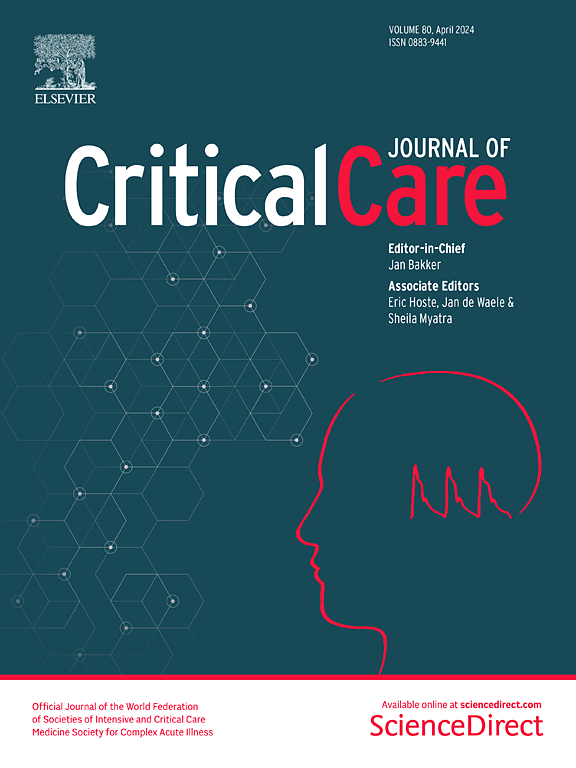Post-discharge functional outcomes in older patients with sepsis
IF 8.8
1区 医学
Q1 CRITICAL CARE MEDICINE
引用次数: 0
Abstract
The post-discharge prognosis of patients with sepsis remains a crucial issue; however, few studies have investigated the relationship between pre-sepsis health status and subsequent prognosis in a large population. This study aimed to examine the effect of the pre-sepsis care needs level on changes in care needs and mortality in patients with sepsis 1 year post-discharge. This was a population-based retrospective cohort study including twelve municipalities in Japan that participated in the Longevity Improvement & Fair Evidence study between April 2014 and March 2022, with a total of 1,491,608 persons. The pre-hospitalization levels of care needs (baseline) were classified from low to high, as no care needs, support level and care needs level 1, care needs levels 2–3, and care needs levels 4–5 (fully dependent). The outcomes were changes in care needs level and mortality 1 year post-discharge, assessed by baseline care needs level using Cox proportional hazard models. The care needs levels of 17,648 patients analyzed at baseline were as follows: no care needs, 7982 (45.2%); support level and care needs level 1, 3736 (21.2%); care needs levels 2–3, 3089 (17.5%); and care needs levels 4–5, 2841 (16.1%). At 1 year post-discharge, the distribution of care needs were as follows: no care needs, 4791 (27.1%); support level and care needs level 1, 2390 (13.5%); care needs levels 2–3, 2629 (14.9%); care needs levels 4–5, 3373 (19.1%); and death, 4465 (25.3%). Patients with higher levels of care needs exhibited an increased association of all-cause mortality 1 year post-discharge after adjusting for confounders [hazard ratios and 95% confidence intervals: support level and care needs level 1, 1.05 (0.96, 1.15); care needs levels 2–3, 1.46 (1.33, 1.60); and care needs levels 4–5, 1.92 (1.75, 2.10); P for trend < 0.001]. Elevated care needs and mortality were observed in patients with sepsis within 1 year post-discharge. Older patients with sepsis and higher baseline levels of care needs had a high association of all-cause mortality 1 year post-discharge.老年败血症患者出院后的功能预后
脓毒症患者出院后的预后仍然是一个关键问题;然而,很少有研究调查了大量人群中脓毒症前健康状况与随后预后之间的关系。本研究旨在探讨败血症前的护理需求水平对败血症患者出院一年后的护理需求变化和死亡率的影响。这是一项基于人群的回顾性队列研究,包括2014年4月至2022年3月期间参与长寿改善与公平证据研究的日本12个市镇,共计1,491,608人。入院前的护理需求水平(基线)从低到高分为无护理需求、支持水平和护理需求水平1、护理需求水平2-3和护理需求水平4-5(完全依赖)。根据基线护理需求水平,采用 Cox 比例危险模型对出院后 1 年的护理需求水平变化和死亡率进行评估。基线分析的 17648 名患者的护理需求水平如下:无护理需求,7982 人(45.2%);支持水平和护理需求水平 1,3736 人(21.2%);护理需求水平 2-3,3089 人(17.5%);护理需求水平 4-5,2841 人(16.1%)。出院后 1 年,护理需求的分布情况如下:无护理需求,4791 人(27.1%);支持水平和护理需求 1 级,2390 人(13.5%);护理需求 2-3 级,2629 人(14.9%);护理需求 4-5 级,3373 人(19.1%);死亡,4465 人(25.3%)。调整混杂因素后,护理需求水平越高的患者出院后 1 年的全因死亡率越高[危险比和 95% 置信区间:支持水平和护理需求水平 1,1.05 (0.96, 1.15);护理需求水平 2-3,1.46 (1.33, 1.60);护理需求水平 4-5,1.92 (1.75, 2.10);趋势 P <0.001]。脓毒症患者出院后一年内的护理需求和死亡率均有所上升。年龄较大的脓毒症患者和基线护理需求水平较高的患者出院后一年内的全因死亡率较高。
本文章由计算机程序翻译,如有差异,请以英文原文为准。
求助全文
约1分钟内获得全文
求助全文
来源期刊

Critical Care
医学-危重病医学
CiteScore
20.60
自引率
3.30%
发文量
348
审稿时长
1.5 months
期刊介绍:
Critical Care is an esteemed international medical journal that undergoes a rigorous peer-review process to maintain its high quality standards. Its primary objective is to enhance the healthcare services offered to critically ill patients. To achieve this, the journal focuses on gathering, exchanging, disseminating, and endorsing evidence-based information that is highly relevant to intensivists. By doing so, Critical Care seeks to provide a thorough and inclusive examination of the intensive care field.
 求助内容:
求助内容: 应助结果提醒方式:
应助结果提醒方式:


